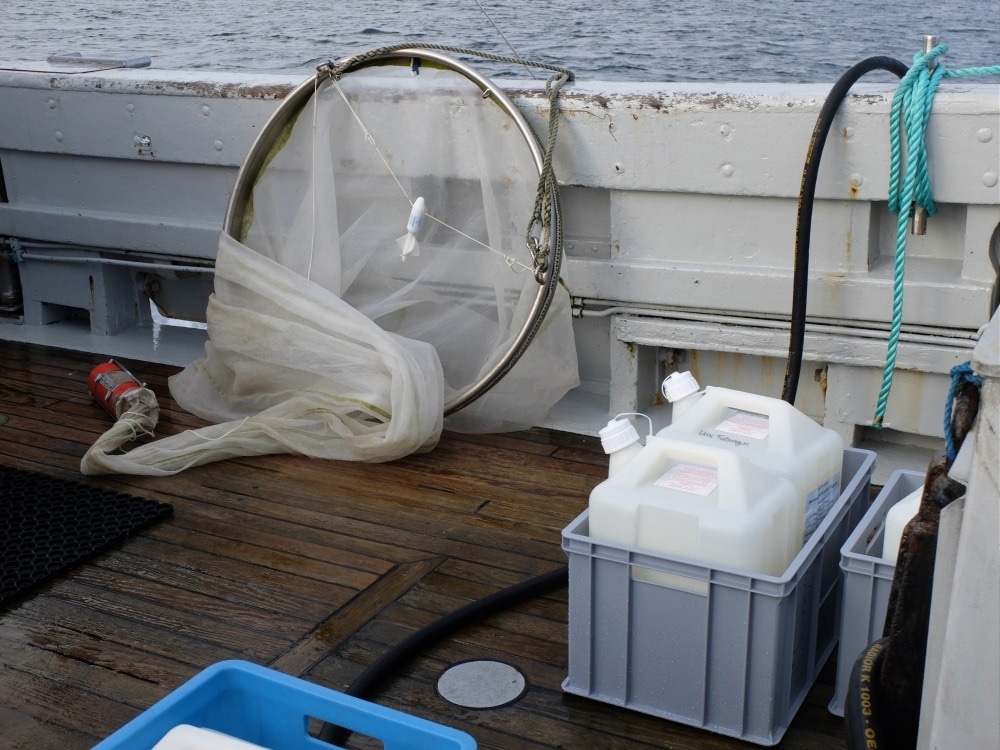An estimated 1500 million liters of oil leak into the ocean each year. This causes widespread environmental pollution because oil encompasses hazardous compounds like polycyclic aromatic hydrocarbons, which can be toxic or mutagenic to organisms.
 Sampling on the ship to study seawater from the North Sea. The seawater is filled into large canisters and cooled and brought back to the lab where the microcosm experiments are conducted. Image Credit: Saskia Rughöft
Sampling on the ship to study seawater from the North Sea. The seawater is filled into large canisters and cooled and brought back to the lab where the microcosm experiments are conducted. Image Credit: Saskia Rughöft
Oil spills, particularly catastrophic ones that cause a large amount of oil to be released quickly into the oceans, like those caused by tanker accidents or incidents at oil drilling platforms like Deepwater Horizon in 2010, are particularly harmful.
Large amounts of chemical dispersants, ranging in the millions of liters depending on the amount of oil, are routinely applied in oil spill incidents to dissipate oil slicks, hinder oil from reaching coastlines, and improve oil dispersion in water.
The hope is that this will improve microbial oil degradation. This is due to the fact that special microorganisms found in nature can feed on crude oil components and break them down into harmless substances. This unique ability of microbes cleans oil-contaminated areas naturally.
In a study from the USA published in 2015, we demonstrated that—contrary to expectation—chemical dispersants in deep-sea water from the Gulf of Mexico can slow down microbial oil degradation. Since then, the topic has been at the center of controversial discussions, and there is still no simple answer to how oil spills can be combated more effectively.
Sara Kleindienst, Professor, University of Stuttgart
Sara Kleindienst worked at the University of Tübingen until 2022.
Biosurfactants may provide a better alternative to chemical dispersants in the search for more environmentally friendly ways of dealing with oil spills. Microbes produce biosurfactants, which can boost the bioavailability of oil components. As a result, microbial oil degradation can be accelerated, which is vital for purification.
Experiments With Seawater From the North Sea
The impacts of biosurfactants and chemical dispersants were matched by an international research group guided by environmental microbiologist Professor Sara Kleindienst, geomicrobiologist Professor Andreas Kappler (University of Tübingen), and biogeochemist Professor Samantha Joye (University of Georgia).
The investigators recreated oil spill conditions in a lab at the University of Tübingen. They collected over 100 liters of surface water from the North Sea near the island of Helgoland for their study. In the presence and absence of oil, the seawater was treated with either the biosurfactant rhamnolipid or a dispersant (Corexit 9500 or Slickgone NS). The researchers used radioactive markers to monitor the oil’s degradation by microbes in great detail.
Our investigations using radioactively labeled hydrocarbons or a radioactively labeled amino acid showed that the highest rates of microbial hydrocarbon oxidation and protein synthesis occurred in the oil microcosms treated with rhamnolipid.
Lu Lu, Professor, China West Normal University
Lu Lu previously worked at the University of Tübingen.
The effects on the composition of microbial communities were also very different when using biosurfactants as opposed to chemical dispersants.
“This result suggests that the use of biosurfactants may stimulate different microbial oil degraders, both in terms of growth and activity, which in turn can affect the cleanup process after oil spills,” emphasizes Prof. Lu Lu.
Our findings suggest that biosurfactants have great potential for use in future oil spills in the North Sea or similar nutrient-rich ocean habitats. A visionary continuation of our work would be the development of products based on biosurfactants that offer both effective and environmentally friendly approaches to combating oil spills.
Sara Kleindienst, Professor, University of Stuttgart
Journal Reference:
Lu, L., et al. (2023) Rhamnolipid Biosurfactants Enhance Microbial Oil Biodegradation in Surface Seawater from the North Sea. ACS Environmental Science & Technology Water. doi.org/10.1021/acsestwater.3c00048.